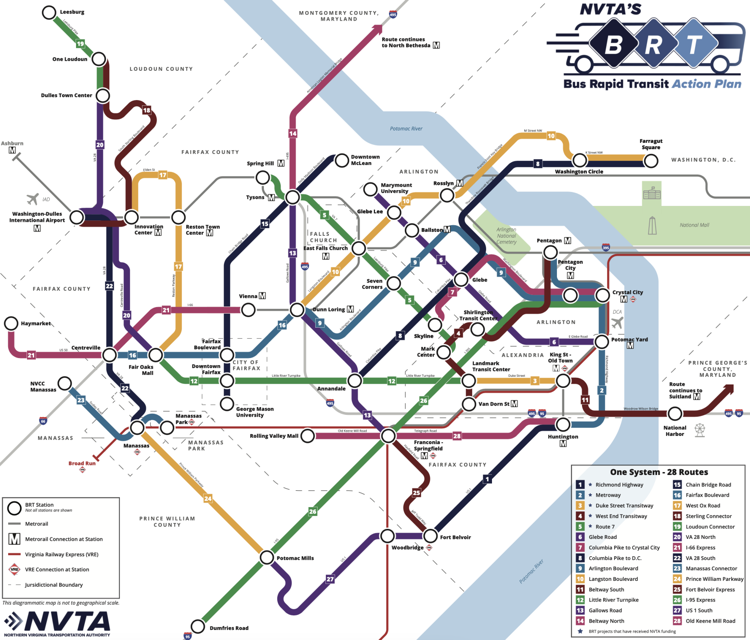Press Release
5/9/25
NVTA implements a Bus Rapid Transit action plan

By Samir Ali Nomani / Fairfax County Times
The Northern Virginia Transportation Authority (NVTA) is implementing a “Bus Rapid Transit” (BRT) action plan to enhance “regional connectivity,” directly serving Alexandria residents. The plan focuses on delivering reliability, efficiency, and quality in public transportation.
The plan maps up to 28 new routes, expanding all-day transit service across Northern Virginia, connecting to D.C. and Maryland.
The newly mapped BRT system adds to the NVTA’s investments in five BRT segments, “totaling more than $880 million.” The segments cover “The One” (Richmond Highway BRT): $638 million; Duke Street Transitway: $87 million; West End Transitway: $20 million; Route 7 BRT: $102 million; and Metroway Extension: $36 million.
Of the five BRT routes currently under various stages of development, two are fully or partially in Fairfax County. These two routes are Richmond Highway BRT (The One) and the Route 7 BRT, which will run from Tysons to Mark Center.
“There are more than 15 routes out of the 28 that are either fully within Fairfax County or connect Fairfax County with neighboring jurisdictions, including Montgomery County and Washington D.C.,” said Abigail Hillerich, the authority’s communications and public affairs manager.
The routes covering Fairfax County run on Gallows Road, Little River Turnpike, Chain Bridge Road, Route 29, Route 50, Route 28, Reston Parkway, and Telegraph Road, among others. “Tysons, Dunn-Loring, Fair Oaks, Franconia-Springfield, and Annandale have multiple routes converging, making them potential hubs,” Hillerich explained.
“All these [routes] will allow travelers in Fairfax County to have better access to fast, frequent, and reliable transit options across the county, connecting them to destinations, including connections to Metro stations,” Hillerich continued.
The Northern Virginia BRT system is predicted to have more than 143,000 boardings on an average weekday in 2045, or more than 47 million riders annually.
In correspondence with a concerned constituent, Monica Backmon, NVTA’s chief executive officer, laid out the cost implications for the system outlined in the draft plan. It includes an estimated $4.2 billion total in 2024 dollars, with 170+ miles of dedicated bus lanes, 270+ upgraded or new BRT stops, 550 BRT vehicles, two new park-and-ride lots, and signal/design upgrades at hundreds of intersections. Additional facilities account for up to $725 million for new bus storage and maintenance facilities. Backmon also included about $192 million annually in cost implications for high-frequency, all-day, seven-day-a-week service.
BRT is a “high-quality bus-based transit system that delivers fast, frequent, and reliable transit service,” the NVTA said. The “defining characteristics” of the system include “high-frequency service, expansive service hours, limited-stop routes, bus priority features, and improved customer facilities.”
NVTA officials state that the BRT system will “support high-ridership capacity and increased reliability over local bus services.”
The authority said the new service will provide Northern Virginia with “new travel options and alternatives to driving, reduced travel times, improved access to jobs and destinations and increased economic growth.”
According to the NVTA, the 28 routes of the BRT system are designed to complement and extend current transit options, including Metro, Virginia Railway Express, and local commuter bus systems to “improve connections to the places where people live, work, and shop.”
The BRT routes are mainly in Northern Virginia, but several routes branch into highly frequented destinations in Maryland and Washington, D.C.
Fairfax County is developing a new BRT service on Richmond Highway, between Huntington Metrorail Station and Fort Belvoir, called “The One.” This service will include 7.4 miles of dedicated bus lanes. The Fairfax County Department of Transportation will implement it with support from other county, state, and federal agencies.
The Richmond Highway BRT project entered the engineering phase of the Federal Transit Administration’s Capital Investment Grant program nearly a year ago. “The project is expected to be operational by late 2033, with an estimated cost of $978.6 million,” said Fairfax County Department of Transportation Head of Communications, Freddy Serrano.
“The One BRT will not only provide mobility improvements but also serve as a catalyst for revitalizing the entire Richmond Highway corridor into a vibrant, economically resilient community,” Serrano told the Fairfax County Times.
The “comprehensive” approach to improvements in the Richmond Highway corridor is referred to as Embark Richmond Highway. It is characterized by road widening, which will be done by the Virginia Department of Transportation, including bicycle and pedestrian improvements, land use changes, and the planning and design of the BRT system.
Implementing a BRT system for Northern Virginia requires investment in stations, bus lanes, technology, and funds to purchase buses and facilities for storing and maintaining fleets. After construction, operating and maintaining the BRT service will incur costs that must be planned for. According to the authority, these costs could be absorbed through various federal, state, regional, and/or local funding sources.
The NVTA said “many Northern Virginia residents” would consider the new service an alternative to driving alone or using other travel options. However, they added that the public would benefit from increased awareness of the new system and its benefits.
The NVTA is seeking public feedback on routes for future funding cycles through an online feedback form. The public will also see the new system map and speak to NVTA staff in person at a series of “pop-up” events.
They will present recommendations to board members and expect the action plan to be adopted in July.
The NVTA is a regional transportation organization “committed to planning, prioritizing, and funding multimodal projects that reduce congestion and enhance connectivity.” The authority says it “develops Northern Virginia’s long-range transportation plan and invests in projects that improve mobility and provide travel options.”